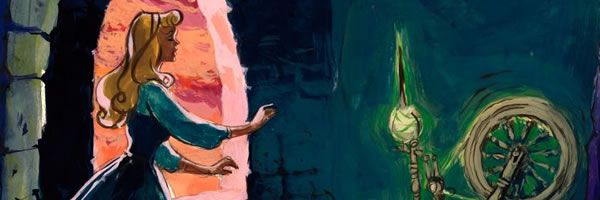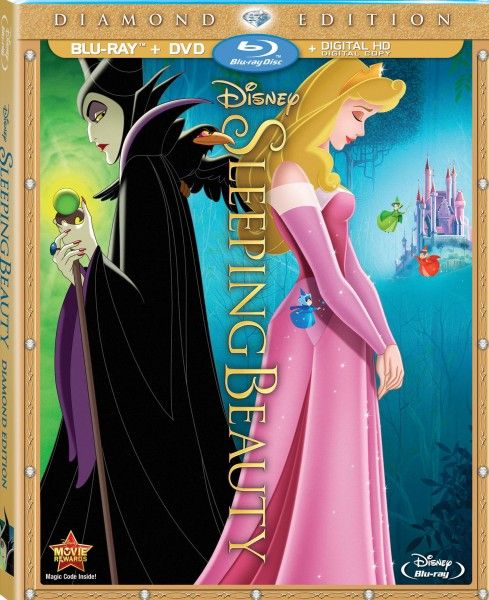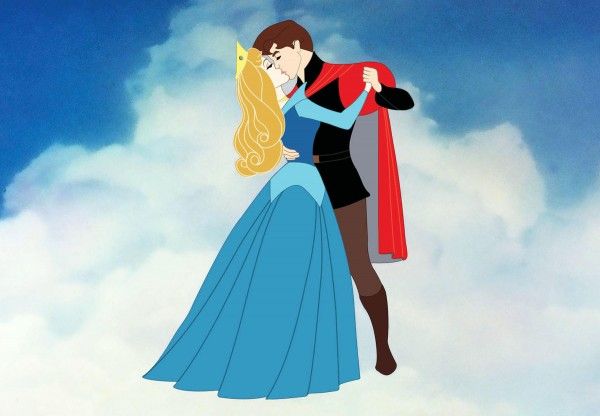Disney’s ultimate princess fairytale classic Sleeping Beauty is now available on Diamond Edition Blu-ray, DVD, Digital HD and Disney Movies Anywhere, with all-new special features. While at the home Walt Disney built on Woking Way in Los Feliz, Calif. in 1932, for an event celebrating Sleeping Beauty and Maleficent, we learned a lot about the development process and the evolution of the artwork, especially from chatting with Doug Engalla, a staff member at the Disney Animation Research Library since 1990.
During a presentation about the evolution of the 1959 animated favorite, which started down a path to development as far back as 1951 and continued right up until its release, Engalla talked about how the story changed, the evolution of the villain Maleficent, and the exacting nature of the artwork. Hit the jump to learn more about the film and the art of Disney animation.
Here are some of the highlights, along with photos of some of the art of Sleeping Beauty:
- Peter Pan and Lady and the Tramp had mixed response, but the success of Cinderella made Walt Disney realize that they needed to tell a story like that again. So, they decided to tell the story of a strong female protagonist that people could cheer for, but he also wanted it to be a different movie, visually.
- The original story of Sleeping Beauty didn’t have very much conflict going for it, as she slept for 100 years before she woke up. So, they went in and redid the whole thing to include a villain. They really built up Maleficent to gave the prince something to fight for.
- Staff artist Eyvind Earle was painting backdrops, but had a very graphic, bold style, and that’s what Disney was looking for with Sleeping Beauty. His influences were gothic art, as well as medieval art and art of the Middle Ages. He created the look and style for the film, that was such a distinctive style that all of the artists in charge of painting backgrounds for the film had to learn how to paint like Eyvind Earle, who was very exacting.
- Maleficent and her raven was inspired by medieval art. In a book of religious paintings, Mark Davis saw a character that had a design of fire as a pattern on the fabric of their clothing, so he started to employ that into her sleeves. The color in her robes went from red to purple, as the character evolved. He designed the headdress to give it that sense of evil because Maleficent was more complicated and an elegant force of evil.
- They were always working on the story, so there were a few different versions of Maleficent was a fairy with antennae, and not the headdress. And she also had a falcon named Diablo as a co-hort. Although the raven was never officially named Diablo in the 1959 film, it has been verified by a lot of the animators that they referred to the raven as Diablo.
-
It was the
first film to be produced in the super wide screen process of techno-rama. Sleeping Beauty was consciously designed for the wide screen, with huge plates of backgrounds and animation. One second’s worth of film is 24 frames, so 24 drawings are required. If you multiply that by a movie that’s nearly 90 minutes, that’s a lot of drawings, so nine years to make the film was about right. Now, the time to make an animated film, from beginning to end, is about three to four years.
- The Disney Animation Research Library is a repository of Disney animation production art. The collection includes about 60 to 65 million pieces, and it encompasses the first 90 years of Walt Disney Animation Studios, starting with some of the earliest films, such as the Oswald shorts and even a piece from one of the Alice Comedies, through to the present day, including Big Hero 6.
- It’s an in-house company with temperature controlled vaults that are humidity controlled. There are specialists in the museum field and the art history field, and they wear gloves when they work with the artwork. Their job is to preserve the entire collection, but make it as accessible as they can. They are working with a digital initiative to catalogue, rehouse and capture the images, so that they can be seen.
- The rarest piece they have is the oldest piece, which is a drawing form one of the Alice Comedies that was recently found accidentally. They opened a package of animation drawings to rehouse them and put them in better condition. Some of the drawings were isolated by makeshift folders, and when they opened up one of the folders, they realized there was a drawing on it. After doing a little research, they realized that it was a character from one of the Alice Comedies, and it’s the only such drawing that they’ve found, so far.
- They get new pieces a couple of different ways. They’ll get phone calls from people at the studio who find something, such as a promotional marionette from Pinocchio. Sometimes they even get stuff sent to them anonymously.
- Sometimes, someone will have faked a piece of art, so they will check with the directors that are still around, in order to verify authenticity.
- The collection includes a background painting of Mickey Mouse in an Army uniform, wearing the hat and saluting. It’s from a government film that the studio made, called “Out of the Frying Pan, Into the Firing Line,” that was supposed to be shown before the main feature to tell everyone in the audience to save their bacon grease to help make better bombs. It’s the only time you see Mickey Mouse in a military uniform, in any of the cartoons.



